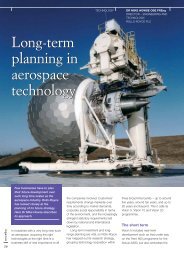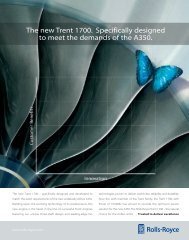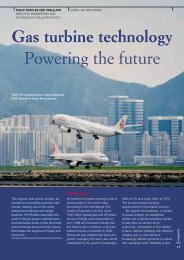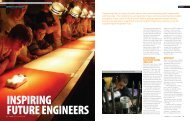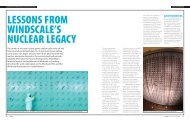The Water Cube swimming hall built for the 2008 Beijing ... - Ingenia
The Water Cube swimming hall built for the 2008 Beijing ... - Ingenia
The Water Cube swimming hall built for the 2008 Beijing ... - Ingenia
Create successful ePaper yourself
Turn your PDF publications into a flip-book with our unique Google optimized e-Paper software.
BOX OF BUBBLES<br />
Visualisation of <strong>the</strong> entrance to <strong>the</strong> <strong>Water</strong> <strong>Cube</strong> – <strong>the</strong> China National Aquatic Centre © Arup/PTW/CCDI<br />
BOX OF<br />
BUBBLES<br />
WEALTH CREATION<br />
<strong>The</strong> <strong>Water</strong> <strong>Cube</strong> <strong>swimming</strong> <strong>hall</strong> <strong>built</strong> <strong>for</strong><br />
<strong>the</strong> <strong>2008</strong> <strong>Beijing</strong> Olympics has already<br />
been described as creative, novel and<br />
wondrous. Arup Fellow, Tristram Carfrae –<br />
based in Australia – describes <strong>the</strong> concept,<br />
<strong>the</strong> planning and <strong>the</strong> engineering<br />
c<strong>hall</strong>enges that enabled <strong>the</strong> construction<br />
of <strong>the</strong> striking structure.<br />
44 INGENIA ISSUE 33 DECEMBER 2007 INGENIA ISSUE 33 DECEMBER 2007 45
BOX OF BUBBLES<br />
WEALTH CREATION<br />
Visualisation of <strong>the</strong> <strong>Water</strong> <strong>Cube</strong> positioned alongside <strong>the</strong> 'Bird's Nest' stadium © Arup/PTW/CCDI<br />
Early in 2003 <strong>the</strong> Municipality of <strong>Beijing</strong><br />
announced a limited design competition <strong>for</strong><br />
<strong>the</strong> <strong>2008</strong> Olympic Games Aquatics Centre<br />
and short-listed 10 international teams,<br />
including our own consortium consisting of<br />
<strong>the</strong> China State Construction and Engineering<br />
Company, PTW Architects and Arup.<br />
Unusually, we at Arup began <strong>the</strong><br />
competition process by outlining to <strong>the</strong><br />
architects what we wanted to achieve<br />
technically, based on our previous experience<br />
with aquatic centres; bringing into play a<br />
whole gamut of engineering disciplines.<br />
HEAT AND LIGHT<br />
As <strong>swimming</strong> pools need to be heated <strong>for</strong><br />
most of <strong>the</strong> year, we decided that <strong>the</strong><br />
solution that solved most of <strong>the</strong> technical<br />
problems was an insulated greenhouse.<br />
Diffused natural light would enter through a<br />
main steel structure <strong>built</strong> within a cavity, to<br />
isolate it from both <strong>the</strong> corrosive pool-<strong>hall</strong><br />
atmosphere and from <strong>the</strong> outside.<br />
Arup also reasoned that ETFE, a<br />
transparent <strong>for</strong>m of Teflon, would be most<br />
efficient <strong>for</strong> such a greenhouse, removing <strong>the</strong><br />
need <strong>for</strong> a secondary structure and providing<br />
better insulation than single glazing. <strong>The</strong><br />
architectural planning team concurrently<br />
calculated that <strong>the</strong> entire square site would<br />
be needed to fit all <strong>the</strong> required facilities into<br />
<strong>the</strong> centre.<br />
At this time Arup learned of <strong>the</strong> winning<br />
design <strong>for</strong> <strong>the</strong> nearby Olympic Stadium, <strong>the</strong><br />
fantastic curvaceous red ‘bird’s nest’ structure<br />
proposed by Herzog and de Meuron/Arup.<br />
With this inspiration, we quickly decided <strong>the</strong><br />
<strong>swimming</strong> centre should be a contrasting<br />
blue box – and so <strong>the</strong> ‘<strong>Water</strong> <strong>Cube</strong>’ was born.<br />
DECIDING THE LOOK<br />
<strong>The</strong> prime c<strong>hall</strong>enge was to decide which<br />
<strong>for</strong>m <strong>the</strong> structure should take and how <strong>the</strong><br />
resulting cladding pattern would look. <strong>The</strong><br />
consortium preferred <strong>the</strong> notion of a<br />
continuous skin that covered <strong>the</strong> walls and<br />
roof alike. Also, we knew that this building<br />
needed to be far from ordinary to win this<br />
top-ranking commission.<br />
Our team discussed a roof structure of<br />
vertical cylinders, clad top and bottom with<br />
circular panels. However, circles do not fit<br />
well toge<strong>the</strong>r and we faced <strong>the</strong> uncertainty<br />
of how to progress from vertical cylinders in<br />
<strong>the</strong> roof to horizontal cylinders in <strong>the</strong> walls<br />
without a clumsy intersection. So we asked<br />
ourselves: if cylinders do not work, what else<br />
will? What sorts of shapes fill threedimensional<br />
space uni<strong>for</strong>mly, besides <strong>the</strong><br />
somewhat prosaic triangulated space-frame?<br />
I suspected nature would provide <strong>the</strong><br />
answer, from living cells to mineral crystals.<br />
However, after much research I realised that<br />
this seemingly innocuous question has no<br />
straight<strong>for</strong>ward answer – in spite of <strong>the</strong><br />
number of natural examples that exist.<br />
We asked ourselves: if cyclinders do not work, what else will?<br />
What sorts of shapes fill three-dimensional space uni<strong>for</strong>mily...?<br />
GEOMETRICAL PUZZLE<br />
I found I was far from <strong>the</strong> first to become<br />
curious about this particular problem. In <strong>the</strong><br />
late 19th century <strong>the</strong> great Lord Kelvin asked:<br />
What is <strong>the</strong> most efficient way to divide space<br />
into cells of equal size with <strong>the</strong> least surface<br />
area between <strong>the</strong>m? Kelvin himself proposed<br />
a highly regular solution to his own problem.<br />
But when we applied <strong>the</strong> 14-sided Kelvin<br />
shape (called a tetrakaidecahedron) it proved<br />
visually uninspiring.<br />
Nor was Kelvin <strong>the</strong> first to seek <strong>the</strong><br />
solution. A century earlier a Belgian scientist,<br />
Plateau, had studied soap bubbles and<br />
devised rules <strong>for</strong> <strong>the</strong> way <strong>the</strong>y join toge<strong>the</strong>r in<br />
three faces <strong>for</strong>ming a line; four lines coming<br />
toge<strong>the</strong>r at <strong>the</strong> tetrahedral angle of 109.4<br />
degrees.<br />
Surely it would be simple to create <strong>the</strong><br />
geometry of a continuous array of soap<br />
bubbles? This would in turn answer Kelvin’s<br />
question because surface tension<br />
automatically minimises <strong>the</strong> surface areas of<br />
<strong>the</strong> partitions between <strong>the</strong> bubbles. At this<br />
point we again found a ‘But’, because Plateau’s<br />
rules simply cannot be applied to create a<br />
geometry that joins toge<strong>the</strong>r.<br />
IT SOLUTION<br />
Much more recent research, however,<br />
provided our answer. A century after Kelvin,<br />
Professor Denis Weaire and his assistant Dr<br />
Robert Phelan used advanced computer<br />
programmes to help <strong>the</strong>m discover a<br />
solution up to two per cent more efficient<br />
than Kelvin’s, subsequently named ‘Weaire-<br />
Phelan foam’.<br />
We soon found a curious feature about<br />
this foam. In spite of its complete regularity,<br />
when it is viewed at an arbitrary angle it<br />
appears totally random and organic. Today<br />
Weaire-Phelan foam has evolved from <strong>the</strong><br />
computer screen of <strong>the</strong> <strong>the</strong>oretical physicist<br />
to <strong>the</strong> actual structure of one of <strong>the</strong> world’s<br />
most novel buildings – <strong>the</strong> <strong>Water</strong> <strong>Cube</strong>.<br />
Our approach to constructing this<br />
building began by visualising an infinite<br />
array of foam, oriented in a particular way,<br />
and <strong>the</strong>n carving out a block <strong>the</strong> same<br />
external size as <strong>the</strong> stadium, 177m by 177m<br />
by 31m. <strong>The</strong> three major internal volumes<br />
were removed from this foam block and <strong>the</strong><br />
result was <strong>the</strong> geometry of <strong>the</strong> structure.<br />
This would <strong>the</strong>n be clad with ETFE pillows<br />
inside and out to gain <strong>the</strong> desired organic<br />
look and to function effectively as an<br />
insulated greenhouse.<br />
Belgian physicist Joseph Plateau made major contributions to three-dimensional geometry and published a<br />
treatise on soap bubbles and film in 1873. Soap films seek to minimise <strong>the</strong>ir surface area/surface energy and <strong>the</strong><br />
optimum shape <strong>for</strong> an isolated bubble is a sphere. Bubbles joined toge<strong>the</strong>r though, have more complicated<br />
shapes © Daniel Loiselle/iStockphoto<br />
How can space be divided into cells of equal size with <strong>the</strong> least surface area between <strong>the</strong>m? In 1993, Denis<br />
Weaire and Robert Phelan used a computer programme to propose a solution whereby three quarters of <strong>the</strong><br />
cells have 14 sides, while <strong>the</strong> rest are dodecahedra with 12 sides. Both sets of cells have <strong>the</strong> same volume and it<br />
was this principle that was taken up <strong>for</strong> <strong>the</strong> <strong>Water</strong> <strong>Cube</strong> © Arup/PTW/CCDI<br />
How <strong>the</strong> structural geometry is extracted from a large block of Weaire-Phelan foam © Arup/PTW/CCDI<br />
46 INGENIA ISSUE 33 DECEMBER 2007 INGENIA ISSUE 33 DECEMBER 2007 47
BOX OF BUBBLES<br />
WEALTH CREATION<br />
Thousands of tubes and nodes interlink to <strong>for</strong>m <strong>the</strong> supporting structure <strong>for</strong> <strong>the</strong> <strong>Water</strong> <strong>Cube</strong> © Arup/PTW/CCDI<br />
MODELLING THE IDEA<br />
Our search <strong>for</strong> <strong>the</strong> most efficient way of subdividing<br />
space had led to a structure based<br />
on <strong>the</strong> geometry of an array of soap<br />
bubbles, clad with plastic pillows that look<br />
just like bubbles – to house <strong>the</strong> water at <strong>the</strong><br />
heart of an aquatics centre! Our team were<br />
convinced <strong>the</strong> scheme would win, but<br />
crucially we needed to ensure we conveyed<br />
<strong>the</strong> idea effectively to <strong>the</strong> judges.<br />
We decided to build an accurate physical<br />
model of all 22,000 steel tubes (which join at<br />
12,000 nodes) and <strong>the</strong> 4,000 different<br />
cladding panels. Rapid prototyping<br />
machinery, more usually used by <strong>the</strong><br />
manufacturing and automotive industries,<br />
seemed to offer <strong>the</strong> only hope, but no-one<br />
had ever made a model this complex.<br />
It took many weeks to learn enough about<br />
computer-aided design modelling and <strong>the</strong><br />
data translation required just to make <strong>the</strong><br />
structural model. With two days left, <strong>the</strong><br />
model was flown from Melbourne to <strong>Beijing</strong>,<br />
where it was joined to a hand-made plastic<br />
skin – it had proved impossible to draw all<br />
<strong>the</strong> different pillow shapes in time. This<br />
completed model helped convince <strong>the</strong><br />
judges and in July 2003 <strong>the</strong> consortium was<br />
announced <strong>the</strong> competition winner and<br />
awarded <strong>the</strong> design commission.<br />
THE STRUCTURE<br />
Next came <strong>the</strong> tricky question: will this<br />
concept actually work?<br />
Our entire attention during <strong>the</strong><br />
competition had focused on <strong>the</strong> model and<br />
we had had no chance to analyse <strong>the</strong><br />
structure. In fact it had proved impossible to<br />
select <strong>the</strong> size <strong>for</strong> each individual structural<br />
element to obtain a structure that would<br />
stand up. So Arup developed new software<br />
that would automatically select <strong>the</strong> member<br />
sizes through an optimisation process – and<br />
<strong>the</strong> result is a remarkably efficient structure.<br />
Be<strong>for</strong>e long <strong>the</strong> entire production process<br />
became automated. One programme<br />
generated <strong>the</strong> entire geometry from scratch,<br />
based on Weaire-Phelan Foam with its<br />
c<strong>hall</strong>enging characteristics (75% of cells in <strong>the</strong><br />
foam have 14 faces, <strong>the</strong> rest have 12 faces…<br />
and all have <strong>the</strong> same volume) and on <strong>the</strong><br />
size and shape of <strong>the</strong> building.<br />
Meanwhile <strong>the</strong> structural optimisation<br />
process sized all <strong>the</strong> steelwork members and<br />
<strong>the</strong>ir connections, and a specially-written<br />
script converted <strong>the</strong> structural analysis wire<br />
frame model into an accurate threedimensional<br />
solid CAD model. Construction<br />
drawings and schedules were produced<br />
automatically from this 3D model.<br />
By <strong>the</strong> end of <strong>the</strong> design phase, we had<br />
created a system that would take less than a<br />
week to generate a whole new set of<br />
construction documents should a major<br />
change to <strong>the</strong> building size or shape be made.<br />
<strong>The</strong> completed <strong>Water</strong> <strong>Cube</strong> building<br />
comprises 4,000 ETFE bubbles, some as large<br />
as 9m across. Seven different sizes of bubbles<br />
feature in <strong>the</strong> roof and 15 in <strong>the</strong> walls,<br />
repeated throughout. Yet <strong>the</strong> eye is still<br />
deceived into seeing a random pattern. ETFE<br />
is a tough, durable plastic that transmits more<br />
ultraviolet light than glass and thoroughly<br />
cleans itself with each rain shower.<br />
Each pillow is permanently inflated by a<br />
low-power pump. This internal air pressure<br />
trans<strong>for</strong>ms plastic just 0.2mm thick into a<br />
cladding panel capable of spanning relatively<br />
large distances. In pillow <strong>for</strong>m, ETFE is also a<br />
better insulator than glass and provides ‘frit’<br />
(dot) patterns to create shading, <strong>the</strong>reby<br />
achieving <strong>the</strong> insulated greenhouse.<br />
FIRE RATING<br />
China’s building code requires a fire rating,<br />
achievable by coating <strong>the</strong> whole structure<br />
with a fire spray or a fire-resistant intumescent<br />
paint. However, with 90km of steel elements,<br />
comprising 6.8 hectares surface area of steel,<br />
<strong>the</strong>se options were not satisfactory.<br />
A complex combination of structural and<br />
fire engineering analysis showed that <strong>for</strong> <strong>the</strong><br />
worse fires <strong>the</strong> building could experience, <strong>the</strong><br />
structure would continue to carry <strong>the</strong> loads<br />
without failure – and so no fire protection<br />
was needed <strong>for</strong> <strong>the</strong> steel.<br />
While ETFE is an amazing material, it is<br />
also combustible. To allow <strong>the</strong> use of this<br />
innovative material we addressed concerns<br />
about its per<strong>for</strong>mance in fire, <strong>the</strong> potential fire<br />
scenarios and <strong>the</strong> consequences <strong>for</strong> safety.<br />
This allowed us to develop appropriate<br />
criteria <strong>for</strong> material selection to provide an<br />
adequate safety level. <strong>The</strong> greatest attribute<br />
Steel structure during <strong>the</strong> construction and be<strong>for</strong>e <strong>the</strong> installation of <strong>the</strong> internal cladding © Arup/PTW/CCDI<br />
of ETFE in fire is that it shrinks away from <strong>the</strong><br />
heat, thus effectively self-venting and letting<br />
smoke out of <strong>the</strong> building.<br />
Egress and circulation routes were<br />
specifically designed to maximise net lettable<br />
area, to provide pleasant and efficient open<br />
circulation routes and to minimise doors that<br />
adversely affect <strong>the</strong> external architecture.<br />
FIRE MODELLING<br />
With an estimated 20,000 people in <strong>the</strong><br />
building at any one time during <strong>the</strong> games,<br />
<strong>the</strong> rigid Chinese code would have required<br />
200m of exit doors – <strong>the</strong> equivalent of two<br />
sides of <strong>the</strong> building. This would not only<br />
spoil <strong>the</strong> look of <strong>the</strong> building but also create<br />
a security problem. Using international<br />
guidelines <strong>for</strong> sporting venues and through<br />
detailed analysis of egress and circulation,<br />
<strong>the</strong> number of exits was reduced<br />
significantly.<br />
Our search <strong>for</strong> <strong>the</strong> most efficient way of sub-dividing space had<br />
led to a structure based on <strong>the</strong> geometry of an array of soap<br />
bubbles, clad with plastic pillows that look just like bubbles – to<br />
house <strong>the</strong> water at <strong>the</strong> heart of an aquatics centre!<br />
TUBES AND BUBBLES<br />
In <strong>Beijing</strong>, <strong>the</strong> structure <strong>for</strong>ms a true space<br />
frame in which all members are framed into<br />
<strong>the</strong> nodes. This might seem inefficient in a<br />
country not prone to major earthquakes, but<br />
<strong>for</strong> <strong>the</strong> seismically active <strong>Beijing</strong> it provides a<br />
perfect energy-absorbing structure. Arup<br />
decided to make <strong>the</strong> structure from simple<br />
circular tubes welded to spherical nodes at<br />
each end to simplify fabrication.<br />
48 INGENIA ISSUE 33 DECEMBER 2007 INGENIA ISSUE 33 DECEMBER 2007 49
BOX OF BUBBLES<br />
WEALTH CREATION<br />
We used a computer model called Fire<br />
Dynamic Simulation to look at how smoke<br />
and heat would spread through <strong>the</strong><br />
building, <strong>the</strong>n tried different smoke exhaust<br />
rates in different areas to keep smoke away<br />
from people as <strong>the</strong>y move through and<br />
leave <strong>the</strong> building.<br />
Built-in fire safety systems such as<br />
sprinklers and smoke exhaust make <strong>the</strong><br />
building safer <strong>for</strong> longer – and allow <strong>the</strong><br />
more open and familiar circulation routes to<br />
be used. This is <strong>the</strong> first time such a major<br />
public building in China has been designed<br />
using a per<strong>for</strong>mance-based fire engineering<br />
approach and <strong>the</strong> design received <strong>for</strong>mal<br />
approval in 2004.<br />
GIANT GREENHOUSE<br />
<strong>The</strong> <strong>Water</strong> <strong>Cube</strong> is designed to act as a<br />
greenhouse. Its ETFE cushions allow high<br />
levels of natural daylight into <strong>the</strong> building<br />
and, as <strong>swimming</strong> pools are predominantly<br />
heating-driven, <strong>the</strong>y harness <strong>the</strong> power of<br />
<strong>the</strong> sun to heat <strong>the</strong> building and pool water<br />
passively. This sustainable concept reduces<br />
<strong>the</strong> pool <strong>hall</strong>’s energy consumption by an<br />
estimated 30%.<br />
<strong>The</strong> system generates an effective<br />
negative U-value or a net energy gain to <strong>the</strong><br />
building. For this principle to work, <strong>the</strong> solar<br />
load entering <strong>the</strong> building offsets its heat<br />
losses. <strong>The</strong> use of <strong>the</strong>rmal mass heat storage<br />
ensures that <strong>the</strong> heat <strong>the</strong> building gains<br />
from <strong>the</strong> sun during daylight is offset by<br />
overnight cooling. <strong>The</strong> <strong>the</strong>rmal mass of <strong>the</strong><br />
pool water and heavyweight surfaces<br />
surrounding <strong>the</strong> pool effectively stores <strong>the</strong><br />
excess heat during <strong>the</strong> day and re-emits it at<br />
night, minimising variation in load.<br />
KEEPING COOL<br />
Variation in shading of <strong>the</strong> facade has<br />
ensured that fabric heat loads are minimised<br />
in summer but maximised in winter, when<br />
<strong>the</strong> solar sun is most beneficial. This is<br />
achieved by patterning <strong>the</strong> various layers of<br />
<strong>the</strong> facade with translucent painted ‘frit’ and<br />
by ventilating <strong>the</strong> heat out of <strong>the</strong> cavity in<br />
summer and containing it in winter. <strong>The</strong><br />
positions and patterns of <strong>the</strong>se translucent<br />
elements have been developed to respond<br />
to <strong>the</strong> daylight and <strong>the</strong> <strong>the</strong>rmal<br />
requirements of <strong>the</strong> various building uses<br />
next to <strong>the</strong> facade.<br />
Energy consumption by <strong>the</strong> large pool<br />
<strong>hall</strong>s is greatly reduced by using <strong>the</strong><br />
displacement ventilation principle in <strong>the</strong><br />
mechanical system. <strong>The</strong> concept of<br />
stratification is critical to achieving high<br />
passive solar heat gains without generating<br />
large cooling loads. By allowing stratification<br />
of air in <strong>the</strong>se large spaces, <strong>the</strong> mechanical<br />
system needs only to provide cooling to <strong>the</strong><br />
occupied spaces, reducing cooling loads;<br />
effectively by a factor of ten.<br />
Air-conditioning will keep non-pool and<br />
office areas to around 23°C in summertime,<br />
with heat rejection of <strong>the</strong> air-conditioning<br />
warming <strong>the</strong> pools. <strong>The</strong> leisure pool must<br />
be kept at around 30°C while <strong>the</strong><br />
competition pool requires 28°C.<br />
AIR CIRCULATION<br />
Swimming-pool centres are very corrosive<br />
environments if not designed properly, so air<br />
distribution is critical. Due to this building’s<br />
unique facade, surface temperature and air<br />
movement must be maintained to prevent<br />
corrosion. Nozzles are located around <strong>the</strong><br />
perimeter of <strong>the</strong> building to supply air up<br />
<strong>the</strong> walls.<br />
During winter, <strong>the</strong>rmal buoyancy lifts<br />
warm air to <strong>the</strong> top. <strong>The</strong> reverse applies in<br />
summer, with cooler air being supplied to<br />
compensate <strong>for</strong> heat gain. This cooler air<br />
does not have <strong>the</strong> same buoyancy <strong>for</strong>ce so it<br />
will not go all <strong>the</strong> way to <strong>the</strong> roof and only<br />
condition <strong>the</strong> lower part of <strong>the</strong> building.<br />
This stratification of air also helps reduce<br />
overall energy consumption.<br />
This smart building is designed to be<br />
able to create a responsive, com<strong>for</strong>table<br />
environment. Spectators’ areas, <strong>for</strong> example,<br />
are air-conditioned by an under-seat supply<br />
system, which will only be switched on<br />
during events. This targets <strong>the</strong> airconditioning<br />
and prevents wastage to areas<br />
not used by spectators and competitors.<br />
<strong>The</strong> <strong>Water</strong> <strong>Cube</strong> nearing completion. It will be <strong>the</strong> venue <strong>for</strong> <strong>the</strong> <strong>swimming</strong>, diving, synchronised <strong>swimming</strong> and<br />
<strong>the</strong> water polo competitions in August <strong>2008</strong> © Martin Saunders Photography<br />
This smart building is designed to be able to create a<br />
responsive, com<strong>for</strong>table environment. Spectators’ areas, <strong>for</strong><br />
example, will be air-conditioned by an under-seat supply<br />
system, which will only be switched on during events.<br />
<strong>for</strong> cost and suitability – <strong>for</strong>tunately <strong>the</strong><br />
<strong>Water</strong> <strong>Cube</strong> emerged unsca<strong>the</strong>d at <strong>the</strong> end<br />
of this process. <strong>The</strong> building was<br />
successfully contracted <strong>for</strong> construction at<br />
<strong>the</strong> original, pre-competition budget of<br />
US$100 million (including early works).<br />
<strong>The</strong> critical item <strong>for</strong> <strong>the</strong> <strong>Water</strong> <strong>Cube</strong>’s<br />
construction were <strong>the</strong> ETFE pillows. <strong>The</strong>se<br />
would be <strong>the</strong> only trade package requiring<br />
procurement from outside of China and<br />
would consume half <strong>the</strong> construction<br />
budget. A British company, Vector Foiltec,<br />
joined <strong>for</strong>ces with a <strong>Beijing</strong> curtain wall<br />
contractor to create <strong>the</strong> best of both worlds<br />
and fabricate, erect, maintain and operate<br />
<strong>the</strong> cladding system <strong>for</strong> a much lesser sum.<br />
<strong>The</strong> cladding package is due <strong>for</strong> completion<br />
in late 2007 in time <strong>for</strong> an official opening<br />
and test event in <strong>2008</strong> prior to <strong>the</strong><br />
Olympics <strong>the</strong>mselves.<br />
This aquatics centre – <strong>the</strong> <strong>Water</strong> <strong>Cube</strong> –<br />
is a pure delight. It solves all <strong>the</strong> technical<br />
problems in one fell swoop. And it achieves<br />
<strong>the</strong> wonderful, if somewhat coincidental,<br />
reality of becoming a building filled with<br />
water, made from a box of bubbles.<br />
CONSTRUCTION<br />
<strong>The</strong> excavation, footings and basement<br />
construction started on site in December<br />
2003. <strong>The</strong>re was a pause in construction<br />
during 2004 while <strong>the</strong> Chinese government<br />
reviewed <strong>the</strong> designs <strong>for</strong> all Olympic facilities<br />
BIOGRAPHY: Tristram Carfrae<br />
Tristram Carfrae is a structural engineer, Principal Director and Arup Fellow.<br />
He is responsible <strong>for</strong> <strong>the</strong> design of award winning buildings and is regarded<br />
internationally as a leading designer of sporting stadia and lightweight, long-span<br />
structures. He was Australian Professional Engineer of <strong>the</strong> Year in 2001 and in 2006<br />
appointed as a Royal Designer <strong>for</strong> Industry by <strong>the</strong> Royal Society <strong>for</strong> <strong>the</strong><br />
encouragement of Arts, Manufacturing and Commerce.<br />
<strong>The</strong> insulated greenhouse captures solar energy directly and uses it to heat <strong>the</strong> pool water and pool <strong>hall</strong> air<br />
50 INGENIA ISSUE 33 DECEMBER 2007 INGENIA ISSUE 33 DECEMBER 2007 51


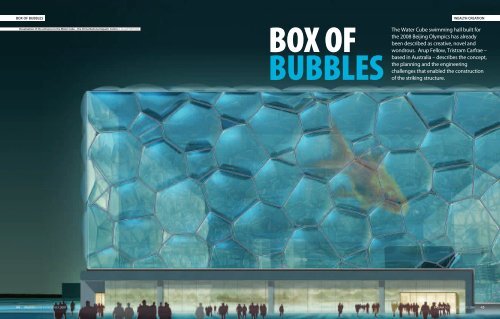


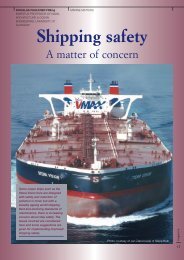
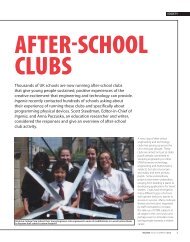

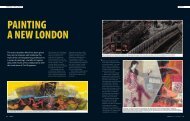
![[322/03] Francke - Ingenia](https://img.yumpu.com/23411337/1/184x260/322-03-francke-ingenia.jpg?quality=85)

